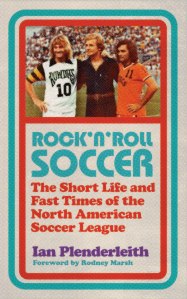Rock ‘n’ Roll Soccer
The Short Life and Fast Times of the North American Soccer League
Ian Plenderleith
I recall, from my childhood, soccer on television, cheering for Pelé and watching him slow-motion bicycle kick his way through Nazis alongside Sylvester Stallone. And then it was gone.
I don’t remember when it went away, but in the early 1980s, my attention turned to music and girls. So long, Pelé. Farewell slow-motion bicycle kick. We hardly new ye. It didn’t even occur to me, until Major League Soccer started play, that there was no longer an elite professional American league.
Fast forward to 2014, and soccer in America is once again on the rise. It’s now expected that the U.S. men’s team will not only qualify, but advance to the knockout rounds of the World Cup. The bar is even higher for the medal-winning women’s club. MLS is approaching its 20th season, and the future is looking bright.
Couple that with the self-immolation of the NFL and in a few decades Monday Night Football might be a whole different ballgame. Literally.
The groundwork for today’s soccer popularity was laid by the North American Soccer League, the subject of Plenderleith’s Rock ‘n’ Roll Soccer. This is required reading in a World Cup year, and a treat to read anytime.
Plenderleith documents the folly, effrontery and ultimate failure of the NASL—an impressively thorough tome that benefits from solid research and a witty outsider’s perspective (though now living in America, Plenderleith is British and brings a European’s passion and insight to football writing).
One of Plenderleith’s great accomplishments in this book is his ability to zoom in and out of the action while keeping the reader engaged. This is not an easy task. At times, he’ll be recounting the exaggerated drug- and drink-fueled antics of over-the-hill international stars and young Americans performing in a flamboyant, fly-by-night federation that defied, in equal measure, rules, tradition and, ahem, sound business practice.
Then Plenderleith will step back and establish the international and cultural context within which the NASL was operating. At first, the international audience mocked the upstart Americans, and FIFA pushed back against the young league that was tinkering with tradition.
But as the NASL achieved early success, the world took notice. While it didn’t reinvent the sport, the outlaw league reinvigorated it by making it a fan-friendly experience and drove rule changes that increased substitutions and decreased back passes.
The model, though exciting, was as unsustainable as that alcohol-fueled borderline relationship you had in college. The peaks were unforgettable, but the valleys unbearable. Sure enough, the NASL folded following the 1984 season.
It was an experiment and experience that was thoroughly American, and though the league didn’t last, it left a lasting impression on the game and paved the way for MLS success.
Rock ‘n’ Roll Soccer is an excellent work of sports journalism and, regardless of whether you follow football or futbol (or both), it is worthy of any fans’ bookshelf.